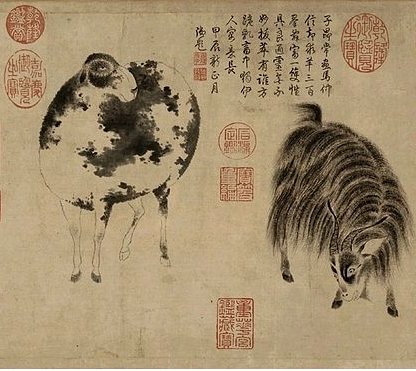3. When in the nights Uranus covered Earth (Gaia) it ought to mean Uranus personified the night sky: ... Uranus came every night to cover the earth and mate with Gaia, but he hated the children she bore him. Hesiod named their first six sons and six daughters the Titans, the three one-hundred-armed giants the Hekatonkheires, and the one-eyed giants the Cyclopes ... The number of the Cyclopes is not given, perhaps because they belonged outside the regular year, and maybe they like Uranus were creatures of the dark. A skin has a front side and a back side. The front side of the Golden Fleece surely was the side with gold, whereas its back side had no hairs and could not contain any golden specks. It was like the reverse of the cover of the night (the back side of the diurnal cycle), when the golden stars always were there. When the 'skin of the night' was turned around, at spring equinox, and the front side of the year once again appeared - when the season of scarce food turned away - the Leader in the sky had returned. Maybe the season of light and plenty was explained as the result of assembling all the golden star specks ('children') of the night. The corresponding kuhane station is probably Te Piringa Aniva, when all the people gathered to give feathers (signs of fire) to the King (their Leader): ... The cult place of Vinapu is located between the fifth and sixth segment of the dream voyage of Hau Maka. These segments, named 'Te Kioe Uri' (inland from Vinapu) and 'Te Piringa Aniva' (near Hanga Pau Kura) flank Vinapu from both the west and the east. The decoded meaning of the names 'the dark rat' (i.e., the island king as the recipient of gifts) and 'the gathering place of the island population' (for the purpose of presenting the island king with gifts) links them with the month 'Maro', which is June ... ... Because of the cold weather, nothing grows (tupu meme), and there is hardly any work done in the fields. Hens grow an abundance of feathers, which are used for the festivities ... The skin of the Lion (in the left hand of Orion) may have been conceived of in the minds of the astrologers when they tried to illustrate the age of the Goat (Capella):
We can imagine the π stars delineating a skin with its hairy side towards the lower right ascension stars, so that Aldebaran could illuminate its front side. The back side of the skin would arrive around 5h (with Capella rising 13m later). On the other hand, the π stars could once - at an even earlier time - have illustrated the outline of a bow, because once Orion was regarded as a hunter. With his bow he could have 'killed' the night (winter), and this idea could have been the origin of similar later such images (cfr e.g. Sagittarius and the Polynesian vero).
Capella can represent the b(l)ack side of the 'skin':
"In Chinese mythology and in Buddhist tradition, a ram or goat was said to be present at the birth of Buddha, Siddhartha Gautama 563–483 B.C. the son of King Suddhodana, ruler of the Sakya tribe. In Tibet at new year, a ram which represents the faults of the previous year is released for the new year, symbolically taking with him last year's faults ..." (Wikipedia)
A black goat with long hair has his head low in contrast to the head of the ram. At the top of the goat is his tail. The ram has a globular body, suggesting the rounded sky with fluffy white clouds. |

